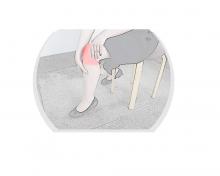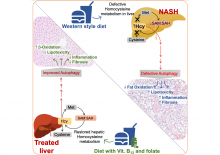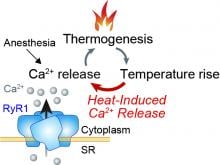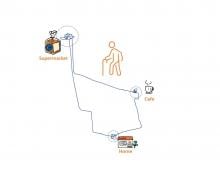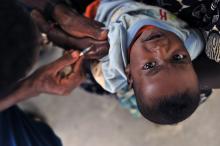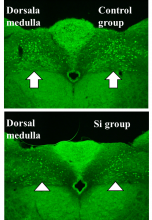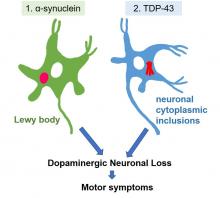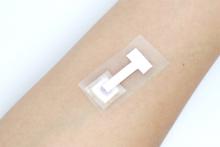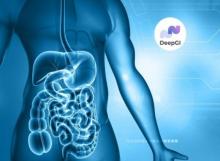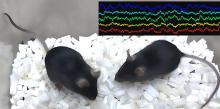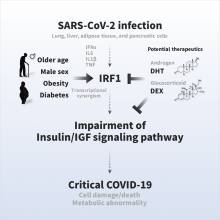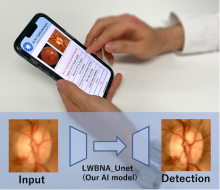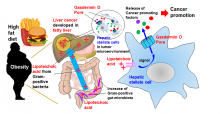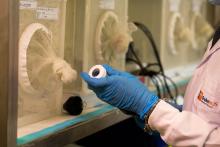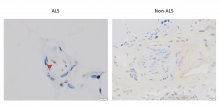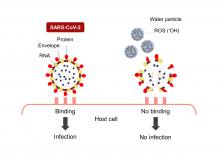Medicine & Healthcare
News
06 Aug 2022
Osaka Metropolitan University scientists revealed quadriceps tendon-patellar bone (QTB) grafts as a more suitable option than bone-patellar tendon-bone (BPTB) grafts for anterior cruciate ligament (ACL) reconstruction. Examinations in human cadavers and ACL reconstruction patients showed that the QTB graft is more similar to the ACL at the femoral insertion site than the BPTB graft. The difference between graft bending angle (GBA) and an angle corresponding to GBA showed that the QTB graft bends less than the BPTB graft, suggesting a lower risk of excessive stress on the insertion site and thereby a lower probability of ACL reconstruction failures. These findings contribute to potential improvement in ACL reconstruction for knee injury patients.
05 Aug 2022
Scientists at Duke-NUS Medical School, Singapore, have found that elevated blood levels of an amino acid called homocysteine correlate strongly with the severity of an advanced form of non-alcoholic fatty liver disease. They also found vitamin B12 and folic acid could potentially prevent and/or delay disease progression.
03 Aug 2022
Researchers have discovered that vitamin K acts as a powerful antioxidant. It can inhibit ferroptosis, a type of cell death associated with Alzheimer’s disease and organ damage, by trapping lipid radicals. Furthermore, the team identified the long-sought-after vitamin K-reducing enzyme, the identity of which remained unknown for more than half a century.
01 Aug 2022
A team of researchers led by Osaka University has found that mutations in the calcium channel protein RyR1 that confer susceptibility to malignant hyperthermia make the protein hypersensitive to heat, which triggers excessive calcium release from the endoplasmic reticulum. Clarifying the mechanism by which calcium release is accelerated at an elevated temperature in patients with malignant hyperthermia may also provide important insight into how exertional heat stroke occurs under extreme environmental conditions.
26 Jul 2022
A research group led by Associate Professor Kazuki Uemura of the Graduate School of Rehabilitation Science, Osaka Metropolitan University conducted a cross-sectional study, using GPS and accelerometers, of 133 elderly people (aged 65 or older) in Toyama Prefecture to investigate their out-of-home behavior and amounts of physical activity during 14 days. The results demonstrated that the amounts of physical activity among the participants were more strongly influenced by the number of visited places (nodes) than by out-of-home time. This suggests that diversity, not just duration, of out-of-home behavior may be important when encouraging the elderly to go out to extend their life expectancy.
23 Jul 2022
Researchers create 'time machine' to study ancestor galaxies, Robotics engineers pay attention to matters of the heart, Custom suits for delivery worms, Tough, light structures with superior impact resistance and Virtual training can reduce stress and anxiety. Read all in the July's Editor's Choice plus op-ed: To boost South Korea’s basic science, look to values, not just budgets, this month's Image & Asia Research News 2022 magazine pick - Better memristors for brain-like computing.
22 Jul 2022
The World Health Organization (WHO) welcomes the launch by Gavi, the Vaccine Alliance, of the landmark opportunity for countries to apply for funding to introduce, or further roll-out, the RTS,S/AS01 (RTS,S) malaria vaccine.
22 Jul 2022
Osaka University researchers designed a silicon-based agent that successfully generated hydrogen continuously in the mouse gastrointestinal tract in an ulcerative colitis (UC) model. The hydrogen served as an antioxidant that could eliminate the reactive oxygen species shown to induce the chronic inflammation responsible for the damage and symptoms caused by UC. Mice given the agent had reduced hemorrhage, inflammation, and hyperexcitability in the brain area associated with visceral pain and discomfort. These results may help with the development of a novel treatment for UC.
20 Jul 2022
The quest for the ideal COVID-19 policies to contain outbreaks without border closures that harm the travel industry led researchers to one protocol.
15 Jul 2022
Cultured human skeletal muscle cells infused with serum from hibernating bears exhibited “muscle gain” confirming that these creatures’ ability to avoid muscular damage despite months of inactivity is in their blood.
15 Jul 2022
A research group led by Dr. Soichi Sano, a specially appointed lecturer in the Department of Cardiovascular Medicine, Graduate School of Medicine, Osaka Metropolitan University, revealed that men with hematopoietic mosaic loss of Y chromosome (mLOY) — meaning men with an increase, in the blood, of cells that have lost the male sex chromosome — have a worse prognosis for heart failure due to fibrosis progression in the heart. Furthermore, in experiments using mice, which, like humans, have an increased mortality rate with age, they found that the presence of mLOY causes overproduction of fibrosis-promoting substances, which leads to the progression of cardiac fibrosis, a mechanism directly related to a worse prognosis for heart failure.
15 Jul 2022
Fresh vegetables in vinegar, similar to pickles, are a perfect side dish, commonly served with Japanese cooking. One traditional side dish called sunomono, a cool cucumber or seaweed salad, provided a unique opportunity as a source of dietary vinegar. This new observational study from Osaka Metropolitan University noted that men over 40 who eat sunomono at least once a month were significantly more likely to be in lower blood pressure categories.
11 Jul 2022
A novel molecular pathway involving cell signalling proteins in the brain may explain how stress affects neuropsychiatric lupus with diffuse neuropsychological manifestations.
05 Jul 2022
23 Gold awarded at MTE 2022: COVID-19 International Innovation Awards and Advanced Healthcare & Life Sciences International Innovation Awards
04 Jul 2022
Researchers from Osaka University have described a case of clinically typical Parkinson’s disease with unusual changes in the brain. As well as the expected findings of cell loss and inflammation in disease-related brain regions, there were accumulations of the protein TDP-43 instead of the usual alpha-synuclein inclusions. This report suggests that TDP-43 accumulation can cause Parkinson’s disease-like symptoms and brain changes, which may be important for developing new treatments for this currently uncurable disease.
02 Jul 2022
An artificial intelligence (AI) algorithm trained to listen to patients pass urine is able to identify abnormal flows and could be a useful and cost-effective means of monitoring and managing urology patients at home. It is presented today at the European Association of Urology annual congress (EAU22), in Amsterdam.
01 Jul 2022
Specialised physician training, nurse-led motivational conversations and follow-up with patients, and subsidy on combination medication significantly lowered BP among patients with uncontrolled hypertension, according to findings from Singapore.
01 Jul 2022
Researchers report a new, minimally invasive, antibody-based detection method for SARS-CoV-2 that could lead to the blood sample-free detection of many diseases
29 Jun 2022
The skin’s top layer contains a diverse set of hundreds of lipid molecules called ceramides with varying chain lengths that play a vital role in its barrier function.
28 Jun 2022
Chula Engineering and Chula Medicine co-invent an innovative device for a rapid and accurate gastrointestinal cancer detection hoping to foster preventive medicine and reduce the number of cancer patients.
27 Jun 2022
A collaborative research group has discovered electrical brain-wave patterns given off during social interactions in mice. They also observed that mice showing signs of stress, depression, or autism lacked these brain waves. The results reveal more about the mechanics underlying brain activity when socializing.
27 Jun 2022
Researchers from Osaka University have found that infection with SARS-CoV-2 activates the expression of IRF1, a key regulator of insulin/IGF signaling in multiple tissues, leading to disruption of blood sugar metabolism and, in some cases, new onset of diabetes. Treating infected cells with hormonal factors that decreased IRF1 expression enhanced insulin/IGF signaling, suggesting that this approach could be used to mitigate some of the more severe side effects of COVID-19 in the future.
24 Jun 2022
Automation in disease diagnosis is reliant on deep learning models that can accurately and efficiently identify measurements of tumors, tissue volume, or other sorts of abnormalities. Now, researchers from Tohoku University have unveiled a new, resource-light model capable of identifying many common eye diseases.
23 Jun 2022
Researchers from Osaka University have found that nematodes can be coated with a protective hydrogel sheath that can be engineered to carry functional cargo. This system could potentially be developed to deliver anti-cancer drugs to tumors using worms with a natural predilection for human cancer cells.
22 Jun 2022
The formation of cell membrane pores is a major mechanism by which cancer-inducing proteins are released and hasten tumor development in nonalcoholic steatohepatitis-associated liver cancer.
21 Jun 2022
• The Satellite Center at Duke-NUS marks the latest achievement for the SingHealth Duke-NUS Academic Medical Centre’s vision for a Discovery District on its Campus.
• It is also the first Asia Pacific site in Johnson & Johnson’s network of research collaborations aimed at addressing endemic and emerging pandemic threats.
20 Jun 2022
Researchers in Japan outline preliminary research that could pave the way for a future test to diagnose ALS, a progressive disease of the nervous system.
17 Jun 2022
Everyone knows that exercise brings physical and psychological benefits. A new study suggests that virtual reality exercise induces similar effects, meaning those with limited mobility may be able to improve their mental well-being.
17 Jun 2022
A research group led by Osaka Metropolitan University and Panasonic Corporation Living Appliances and Solutions Company discovered how nano-sized electrostatic atomized water particles disinfect SARS-CoV-2. The nano-sized electrostatic atomized water particles developed by Panasonic Corporation have an electron rich nano-sized water shell that contains reactive oxygen species. The researchers showed that the water particles damage the viral envelope, protein, and RNA. They also revealed that the damaged virus did not bind to host cells. These phenomena are considered the main inactivation mechanism of the nano-sized electrostatic atomized water particles on SARS-CoV-2.
13 Jun 2022
Themed “Roll Back Dengue” and organised as a hybrid event, the three-day summit will congregate dengue community including over 200 clinicians, researchers, government public health leaders and policymakers across Asia
Events
Sorry, nothing coming up for this discipline
- « first
- ‹ previous
- 1
- 2
- 3
Researchers
Sorry, nothing coming up for this discipline
- « first
- ‹ previous
- 1
- 2
- 3
Giants in history
Sorry, nothing coming up for this discipline


